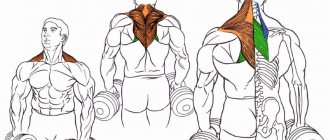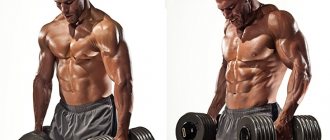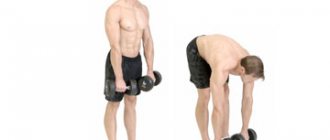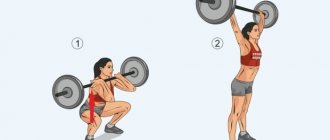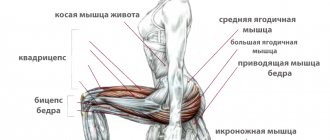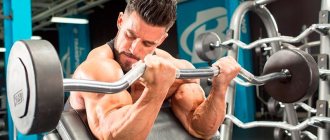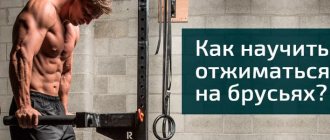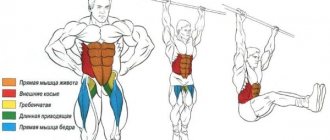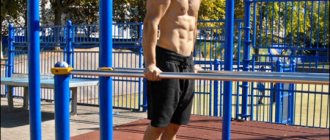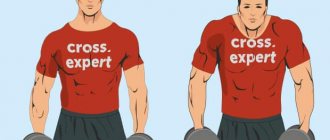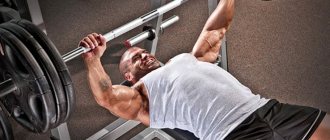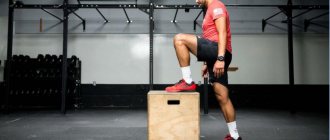Shrugs are an isolation exercise that develops the upper trapezius muscle, which is clearly visible in professional bodybuilders. For beginners, this exercise is not necessary, since it is better to train the trapezius with basic exercises, which will first tone the muscles. Shrugs are performed in various variations, the technique of which should also be thoroughly worked out.
Minuses
- When using too much weight with incorrect technique, the exercise causes pain in the lower back and shoulder joints.
- Rotational movements of the shoulders reduce the contractility of the trapezius, reducing the load on them.
- The exercise is not suitable for those who have problems with the spine (vertebral displacement, pinched nerves, hernia, protrusion of intervertebral discs). These are the main contraindications to performing this exercise.
- Excessive load on the trapezius causes the opposite effect of the exercise - curvature of posture and hypertonicity of the trapezius muscle.
Common mistakes
- Violation of the amplitude of movement. This means that the amplitude is too small, so the lift height is not enough to reduce the trapezoid. Getting rid of the error is quite simple. With each repetition, you need to imagine that you are trying to reach your ears with your shoulders. There is another option: you need to practice the exercise with less weight.
- Perform the movement by pressing your chin to your chest. The mistake allows you to overstretch the neck muscles and can lead to a pinched nerve. And for most people this does not achieve results.
- Biceps Curl. This movement only removes part of the load from the trapezius, allowing the arms to move by inertia. Bicep curls can also cause injury to the elbow and wrist. Therefore, it is necessary to monitor the position of the hand in the exercise.
- Excessive training of the trapezius muscles. Many people think that the trapezius is a small muscle group and recovery does not take much time. This is a common misconception. The trapezius should not be trained more than once a week. This frequency results in the most progress.
- Ignoring the belt if your back is weak. When using the maximum weight, it is important not to forget about the belt. This will not only avoid technical errors, but also maintain your back health.
Shrugs with a barbell: execution technique
Although the exercise allows you to lift heavy loads, it should be increased gradually. Use the mixed-grip technique, alternating the position of the hands (in pronation and supination) each approach - this will allow you to hold a large weight of the barbell and evenly distribute the load on the trapezius.
- When performing the front barbell technique, place the bar on the racks just below your pelvis.
- Grab the bar with an overhand grip, slightly wider than shoulder-width apart. Remove the barbell, move a little away from the racks and place your feet shoulder-width apart.
- As you exhale, raise your shoulders, doing “shrugs”; at the peak, feel the maximum contraction of the trapezius. Pause for a second at the peak of the contraction. Perform full range of motion.
- As you inhale, lower your shoulders, slowly stretching your trapezius.
Important! Do not bend your elbows when lifting the barbell to eliminate additional help from your biceps. Move your shoulders strictly along the vertical axis, do not rotate your shoulders.
Tips for starting position
When performing shrugs with a barbell while standing, it is necessary to remember that the athlete’s starting position is to be in a horizontal position with his feet placed shoulder-width apart and also fixed on the floor surface. Your shoulders should be pulled back, your back should be straight, and your posture should be kept as straight as possible.
The athlete's chest moves forward to provide the lungs with sufficient air supply while working with sports equipment. The neck is pulled back slightly into the shoulders, and the chin is lowered down and pressed towards the chest. This is the classic starting position for standing barbell shrugs and minimizes the risk of injury.
Shrugs with a barbell behind your back
In the exercise, the upper trapezius, rhomboid and levator scapulae muscles are subjected to heavy load and maximum contraction. This technique allows you to avoid “sagging” your shoulders forward by bringing your shoulder blades closer together.
- Place the bar on the racks at the level of your buttocks, turn your back to the bar.
- Take an overhand grip slightly wider than shoulder width, with the back of your hand facing forward.
- Carefully remove the barbell by taking a step forward.
- Place your feet hip-width apart and move your shoulders back. Don't round your back.
- As you exhale, raise your shoulders to your head as much as possible, feeling a burning sensation in your trapezius.
- Lower your shoulders and stretch your muscles as you inhale.
Important! Choose the correct weight of the barbell; the weight should not overweight and tilt the torso back, overloading the lower back.
Weight selection
The weight should be such that you can perform at least 8 repetitions in one set. Shrugs with an overly heavy barbell will not allow you to raise your shoulders as high as possible, and the effect of the exercise will be less than expected.
At the same time, the weight should not be small. At the end of each approach, a distinct burning sensation should be felt in the trapezius. If the tension feels good and there are signs of muscle fatigue, then the result will appear soon.
About home workouts for back muscles >>
Shrugs in Smith
This option is perfect for beginners too. The Smith machine allows you to perform the exercise without insurance; in case of muscle failure, you can instantly lock the bar.
- Place the bar just below your pelvis.
- Grasp your palms with an overhand grip, slightly wider than shoulder-width apart.
- Remove the crossbar from the locks.
- As you exhale, raise your shoulders to your head as much as possible without bending your elbows or leaning your body. Make a faster upward movement, pausing for a second at the top.
- As you inhale, lower your shoulders, stretching the muscle.
You can also perform shrugs with a bar behind your back in Smith. The technique is the same as with the barbell version.
Important nuances and recommendations
It should be remembered that the trapezius muscle is one of the largest on the back, so it is extremely important to follow certain rules:
- Before training, you need to warm up well. Short cardio, for example, 30 minutes of jogging, will not be superfluous.
- You should never start with heavy weights. Initially, the technique of performing shrugs is worked out, and only then the load is added.
- Only those muscles and joints that the exercise is aimed at should work (dangling elbows and wrist joints is unacceptable).
- You cannot bend your back and round your shoulders - this can lead to protrusions and herniations of the spinal disc.
In addition, you need to carefully monitor your breathing. The correct approach is to alternate inhalations and exhalations during the exercise.
When your arms are down and holding the barbell, you cannot relax your hands. The weight should not pull the arms down, otherwise the shoulder, elbow and wrist joints may be damaged. Even during rest, muscles need to be kept in good shape.
The shrug exercise is contraindicated for people with diseases of the spine, joints, especially the knees or shoulders.
It is best to select the weight of the barbell according to your level. For beginners, this is no more than 10–20 kg for women and 20–23 kg for men. Experienced athletes often trust their intuition and experience in this matter. But it is always worth remembering that it is better for the back muscles to perform many approaches with light weight. On average, this is 2-4 pull-ups of 10-14 repetitions.
By following the rules listed above, the athlete maintains his health and at the same time develops the trapezius muscles. The main thing is to remember the 3 principles of training: moderation, patience and a thoughtful approach. As a result, after a short period of time you will be able to proudly demonstrate your sculpted back and excellent posture.
Shrugs with dumbbells
Dumbbell shrugs can be performed standing or seated. The standing option is the safest, since shrugs in a sitting position, due to the weight of the dumbbells, place more stress on the lumbar spine.
- Take dumbbells in both hands, take a stable position, your feet should not be wider than your pelvis.
- Hold dumbbells at the sides of your body with straight arms.
- As you exhale, lift your shoulder blades, feeling the maximum contraction of your upper trapezius. Pause for a second at the top point.
- As you inhale, slowly relax your muscles and return to the starting position.
Benefits of exercise
The trapezius muscle not only helps us raise and lower our shoulders, but also allows us to bring our shoulder blades closer to our spine and rotate our shoulders away from each other. It helps in lifting all types of weights from the floor, and stabilizes the shoulders when we do pull-ups or pull the barbell to the waist. Strong trapezius is a good “helper” in lift-ups, power cleans and other weightlifting movements.
Working out the trapezius with shrugs helps get rid of the feeling of stiffness in the shoulders and back that haunts those who are engaged in office work or drive a lot. This movement improves blood circulation throughout the upper body and nutrition of the brain. Sometimes simply adding shrugs to your workout plan will relieve headaches better than any manual therapy.
The applied sports aspects of the exercise are significant. Without working on the trapezius muscle, it is difficult to imagine a high-quality “assembly” of the back in squats and bench presses, as well as work in deadlifts. The trapezius muscles help the athlete efficiently perform all types of basic exercises that involve the back. Without working on the trapezius, it is difficult to imagine shoulder training in bodybuilding, because with an undeveloped trapezius, the figure will never be harmonious.
Important: Strong neck muscles are important in wrestling or extreme sports. Athletes of these types can incorporate shrugs into their general physical training to protect the cervical spine from injury and reduce the risk of spinal injury.
There are no complete contraindications, with the exception of two cases:
- Violation of the outflow of venous blood (pathology of venous valves);
- Severe scoliosis in the thoracic region
Domestic sources also add hernias in the lumbar region here, Americans are not so radical, they believe that hernias are not a hindrance, it is enough to qualitatively strengthen the rectus abdominis muscle and the muscles running along the spine.
For women there are two options. In strength sports you will just have to accept some increase in trapezius. All the same, it won’t be possible to pump up something really huge there, and the model’s puny shoulders won’t withstand the weight that girls usually squat. But for those who exercise simply for fitness, it makes sense to do exercises for the trapezius muscle not in failure mode, and perform about 20-25 repetitions to achieve fatigue, but not failure. This way the muscles will not grow significantly, and hypertrophy will not be achieved.
Shrugs on uneven bars
This technique targets the lower trapezius by performing a reverse shrug, with the muscles being stressed at the bottom of the movement.
- Grasp the handles, remaining hanging, stretch your neck upward, moving your shoulders away from your head as much as possible.
- As you inhale, slowly lower yourself to the lowest point on straight arms, lowering your head to your shoulders, and hold at the peak of the contraction.
- As you exhale, return to the starting position.
Shrugs on an incline bench
By performing shrugs while lying on your stomach at a 45-degree angle, you can train your upper trapezius as well as your upper back. The exercise will help develop correct posture. This option significantly relieves the load on the lower back and legs.
- Lie on an incline bench with your stomach down. Take the dumbbells from the stands for convenience.
- Stretch your traps in the lower position. Arms with dumbbells are straight.
- As you exhale, raise your shoulders as high as possible, bringing your shoulder blades towards each other, and hold for a second at the peak of the contraction.
- As you inhale, lower your shoulders.
Do not train the retractor scapulae muscles
What retraction of the shoulder blades is can be seen using the example of a cat's paw. Cats can extend and retract their claws using small muscle fibers on the “soles of their feet.” In order to release their claws, they tense them, and when they relax, the claws retract back. Blades work on a very similar principle. The middle part of the trapezius muscle retracts them. When we try to connect the shoulder blades, we tense the trapezius, as in the picture.
It is necessary that the yellow arrows meet on the white line. This is how the middle part is trained. In addition, this is the largest part of the trapezoid. If shrugs or other exercises do not include this movement (retracting the shoulder blades), then you cannot expect particularly good results. This is why shrugs alone are not enough. What exercises should you do? You might think that this can be achieved by training on a rowing machine. In principle, this is correct, but the exercises should be performed with an emphasis on bringing the shoulder blades together. The easiest way to achieve this is to keep your shoulders back. When performing a shrug, you need to focus on moving the load back (to your back). In this case, the shoulder blades retract (close).
